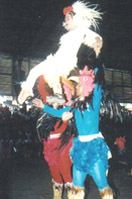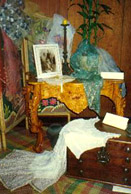September 1-8
Sarakiki Festival
Calbayog City
According to the legendary story of Ilahas, Sarakiki
came from the word "sakingking" (originally "nakingking") which means to
allure, to provoke an enemy, to fight, to deter an opponent, to enchant or
bewitch. Sarakiki is manifested in courtship, songs, war dance,
kuratsa, and rituals or "hadang".
Ethnographically, Calbayognons' celebrate their community life in arts and
culture. Stage performances, dance competitions and songs combine to
form unique expressions of their existence, occupations, political
sovereignty and socio-cultural life. Cultural forms that have survived
through the years are still characterized by these elements: Ismyling,
Kuratsa, Siday. They still showcase the rich diversity of
Calbayog's cultural heritage today.
Sarakiki aptly describes the rare event that bids to celebrate life and
culture. Cultural practitioners, institutions, and existing cultural
groups come together for this meaningful cultural endeavor -- aiming for the
preservation of Filipino culture in our determined quest for sovereignty and
identity.
The essence of the festival is the aspiration of the people through song and
dance as well as commemorate the life of Ilahas, the legendary hero of
Ibatan (Calbayog).
Sarakiki street dance is characterized by the movements of the cock.
With thumbs up to form like "tahod", the performers wear costumes
inspired by the appearance of the cock such costumes may be modified,
improvised and made relevant. The movements will be accompanied by
original music made out of drums and other ancient Samareņo musical
instruments.
September (World Tourism Day)
Regional Tourism Quiz
Tacloban City
Inter-high school quiz on domestic and international tourism
topics to create tourism awareness and encourage the active participation of
the studentry in the promotion of Eastern Visayas as a tourist destination.
September (movable)
Parayaw han mga Kada-an
Linggo ng Kasuotang Pilipino
Tacloban City
The attire is an eloquent manifestation of national heritage
and culture.
Thus, the observance of the "Linggo ng Kasuotang Pilipino" has been
implemented by the Departement of Tourism to project the unique Filipino
identity; create a sense of pride in being Filipinos; and to give due
respect to Filipino heritage and culture.
The exhibit features baro't saya, binabaye, cayab, sando, salico, lo-on,
enaqua, candonga and panuelo of women who willingly agree to show
their period gowns and dresses for young generations to have a glimpse into
our culture and heritage.
September 7
Padul-ong
Borongan, Eastern
Samar
"Padul-ong" relates how the Lady of Nativity became the
Patroness of Borongan. Legend states that a mysterious woman boarded a
Portuguese ship despite the captain's initial refusal. The voyage went
smoothly. However, the captain failed to serve water/food to the woman
guest. She lay dead and beside her was a wooden cargo with the
inscription Nuestra Seņora de Borongan. The captain immediately
ordered the unloading of the box and turned it over to the elders. The
box contained the image of a beautiful woman cradling a child in her lap.
It was enshrined at Punta Maria. The lady is said to frequent the
Hamorawon Spring in Borogan as evidenced by floral scent that swept the
vicinity. Devotees came because of the miraculous curative power of
the spring water. The image at Punta Maria was then transferred to
Borongan. Thus, began the Padul-ong with the villagers transferring
the shrine on board the "bilos" to Sabang barangay unto the Roman Catholic
Church.
The sacred image symbolizes the Nativity of the Blessed Mother henceforth
the blessed patron of Borongan. Today, this folk religious practice
focuses on an elaborately decorated carriage from the church to the
residence of the Hermano of the incoming fiesta.
September 28
Balangiga Incident
Balangiga, Eastern
Samar
The 1901 Philippine-American encounter is commemorted through
a pageant as a reminder of the Filipinos' quest for freedom.
September 28
Banigan-Kawayan
Festival
Basey, Samar
Banig is the unquestioned identity of Basey. Say "banig"
and the town of Basey immediately comes to mind. Banig, the mat,
banigan, the industry, have been existing in Basey since generations were in
Binongtuan. In the early days, the tikog straw (raw materials for
banig) were woven into mats. These mats served several purposes: as
bedspread, as mats on which palay, corn and other farm products were spread
for drying, as temporary shelter from the hot sun, or the rain. These
days, one can see not only banig mats but also banig wall decors, banig
bags, banig room dividers and name it, banig has it. Embroaidered with
dyed buri strips, banig beauty if unequaled in its uniqueness which only the
banig of Basey can possibly have.
Together with the banig, the "kawayan" - bamboo - is also identified with
Basey. From the kawayan, one can have kawayan sala sets, kawayan
bric-a-bracs, kawayan outriggers, not to mention the kawayanhouses.
There are also the kawayan traps for catching crabs, fish and other seafood.
We also have different headwear from kawayan strips. Kawayan baskets
are made in the barangays of Mabini, Baloog, Canca-iyas and Basiao.
To showcase the banig and the kawayan as truly unique to Basey,
the Banigan-Kawayan Festival is celebrated. he festival street dances
feature the beautiful products made of banig and kawayan.
|

[ sarakiki ]
↑

[ Filipino kasuotan ]
↑

[ banig beauties ]
↑
|

![]()
![]()


